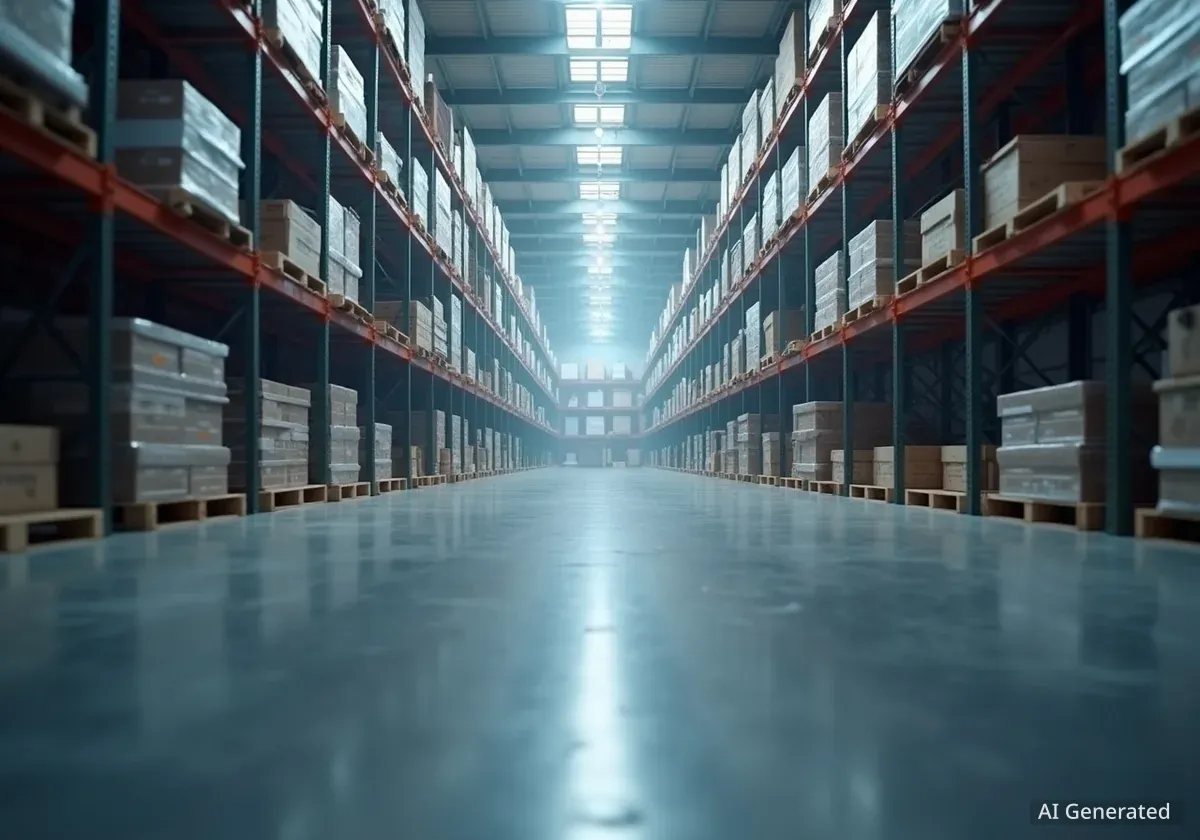The United States warehouse market showed signs of stabilization in the third quarter of 2025, as the national vacancy rate held steady at an 11-year high. A significant increase in demand for industrial space, combined with a slowdown in new construction, prevented the vacancy rate from climbing for the first time in three years.
According to a new report from commercial real estate services firm Cushman & Wakefield, the average warehouse vacancy rate across the country was 7.1% for the three-month period ending September 30. This figure is unchanged from the second quarter, signaling a potential turning point after a prolonged period of increasing supply.
Key Takeaways
- The national warehouse vacancy rate remained at 7.1% in Q3 2025, an 11-year high but unchanged from the previous quarter.
- This marks the first time in three years that the vacancy rate did not increase, suggesting a market shift.
- Demand for industrial space, measured by net absorption, rose to 45.1 million square feet, a 30.4% increase from Q2.
- The completion of new warehouse projects decreased by 14.6% compared to the previous quarter, contributing to market stabilization.
Market Reaches a Plateau After Years of Expansion
For the first time in 36 months, the amount of available warehouse space in the United States did not grow. The 7.1% vacancy rate, while still the highest in over a decade, indicates that the market may be finding its balance after a period of rapid expansion fueled by the e-commerce boom.
This halt in rising vacancies is a notable development for the commercial real estate sector. For the past three years, a steady stream of new construction projects consistently outpaced demand, leading to a gradual increase in empty industrial properties. The third-quarter data suggests this trend has paused, primarily due to shifts on both the supply and demand sides of the equation.
Background: The Post-Pandemic Construction Boom
The period from 2021 to 2024 saw unprecedented growth in warehouse construction. Driven by a massive consumer shift to online shopping, companies raced to build larger and more efficient distribution centers to manage inventory and shorten delivery times. This resulted in a surplus of available space as construction pipelines eventually overtook immediate demand.
The stabilization at 7.1% provides a new baseline for the market. Analysts are now closely watching to see if this plateau represents a temporary pause or the beginning of a new cycle where demand begins to consistently absorb the available supply.
Surge in Demand Drives Market Activity
A key factor behind the stable vacancy rate was a significant uptick in demand. The net amount of newly occupied space, a metric known as absorption, reached 45.1 million square feet in the third quarter. This represents a substantial increase in leasing activity and business expansion within the industrial sector.
The figure is particularly noteworthy when compared to the previous quarter. The Q3 absorption rate was 30.4% higher than the total recorded between April and June. This sharp increase suggests that businesses, after a period of caution, are once again leasing space to store goods, manage supply chains, and fulfill orders.
By the Numbers: Q3 Market Dynamics
- Vacancy Rate: 7.1% (Unchanged from Q2)
- Net Absorption: 45.1 million square feet
- Quarter-over-Quarter Absorption Growth: 30.4%
- New Construction Completions: Down 14.6% from Q2
This renewed demand could be attributed to several factors, including retailers restocking inventory ahead of the holiday season and companies implementing more resilient, diversified supply chain strategies that require holding more goods domestically. The strong absorption numbers demonstrate underlying health in the logistics and distribution industries.
New Warehouse Construction Continues to Slow
Complementing the rise in demand was a continued slowdown in the delivery of new warehouse projects. The amount of newly completed industrial space in the third quarter fell by 14.6% compared to the second quarter. This decline is a direct response to the market's high vacancy rates and a more cautious economic outlook.
Developers have been scaling back on new projects over the past year. Higher interest rates have made financing for large-scale construction more expensive, while the existing surplus of space has reduced the urgency for speculative building—where facilities are constructed without a tenant already secured.
"The data indicates a market that is actively self-correcting. The reduction in new supply, coupled with a healthy rebound in tenant demand, was essential in preventing vacancies from rising further," noted an analyst reviewing the Cushman & Wakefield findings.
This reduction in the construction pipeline is crucial for the market's long-term health. By allowing demand to catch up with the existing supply, the sector can avoid a prolonged period of oversupply, which would put downward pressure on rental rates and property values.
Outlook for the Industrial Real Estate Sector
The third-quarter results provide a cautiously optimistic outlook for the U.S. warehouse market. The balance between supply and demand appears to be improving, which could lead to a more stable and predictable environment for both landlords and tenants in the coming months.
What to Watch Next
Industry experts will be monitoring several key trends heading into the final quarter of 2025 and beyond:
- Sustained Demand: Will the absorption rate remain strong through the end of the year, or was the Q3 surge a temporary event driven by seasonal factors?
- Construction Pipeline: How many new projects are scheduled to break ground in 2026? A continued disciplined approach to new construction will be vital for maintaining market balance.
- Rental Rates: With vacancy rates no longer rising, landlords may have more leverage to hold firm on rental prices. Any significant changes in asking rents will be a key indicator of market direction.
- Economic Indicators: Broader economic conditions, including consumer spending and manufacturing output, will continue to influence the need for industrial and logistics space.
While the market is not yet out of the woods, the stabilization of the vacancy rate is the most positive signal the sector has seen in years. It suggests that the fundamental need for modern, efficient warehouse space remains strong, even as the market adjusts to a new post-pandemic reality.





